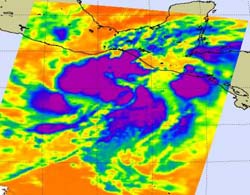NASA eyes low in eastern Pacific for tropical development

NASA\'s Aqua satellite infrared image on May 27 at 1:35 a.m. EDT showed System 90E with four areas of strong thunderstorms with very high, cold cloud tops (purple) around the center of circulation. Credit: NASA JPL, Ed Olsen<br>
AIRS, the Atmospheric Infrared Sounder instrument on Aqua, provides scientists with infrared satellite imagery. That imagery measures cloud top temperatures and sea surface temperatures. If the cloud tops in low pressure areas or tropical cyclones are colder than -63 degrees Fahrenheit, it indicates strong thunderstorms and strong convection (rapidly rising air that condenses and forms the thunderstorms that power tropical cyclones).
On May 27 at 1:35 a.m. EDT (05:35 UTC) AIRS imagery showed System 90E developing the trademark tropical cyclone approximately 205 nautical miles south of Salina Cruz, Mexico near 12.8 North and 94.5 West. AIRS infrared imagery indicated there were four areas of strong thunderstorms with very high, cold cloud tops around the center of circulation. Infrared satellite imagery indicates a slowly consolidating, broad low-level circulation center.
Winds in the area are estimated to be 20 to 25 knots (23-28 mph). System 90E is trudging west at 1 mph. The Joint Typhoon Warning Center noted that System 90E “is expected to continue consolidating over the next 24-36 hours. The potential for the development of a significant tropical cyclone within the next 24 hours is good.”
Media Contact
More Information:
http://www.nasa.govAll latest news from the category: Earth Sciences
Earth Sciences (also referred to as Geosciences), which deals with basic issues surrounding our planet, plays a vital role in the area of energy and raw materials supply.
Earth Sciences comprises subjects such as geology, geography, geological informatics, paleontology, mineralogy, petrography, crystallography, geophysics, geodesy, glaciology, cartography, photogrammetry, meteorology and seismology, early-warning systems, earthquake research and polar research.
Newest articles

Webb captures top of iconic horsehead nebula in unprecedented detail
NASA’s James Webb Space Telescope has captured the sharpest infrared images to date of a zoomed-in portion of one of the most distinctive objects in our skies, the Horsehead Nebula….

Cost-effective, high-capacity, and cyclable lithium-ion battery cathodes
Charge-recharge cycling of lithium-superrich iron oxide, a cost-effective and high-capacity cathode for new-generation lithium-ion batteries, can be greatly improved by doping with readily available mineral elements. The energy capacity and…

Novel genetic plant regeneration approach
…without the application of phytohormones. Researchers develop a novel plant regeneration approach by modulating the expression of genes that control plant cell differentiation. For ages now, plants have been the…





















